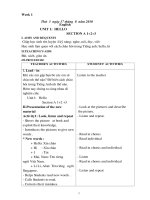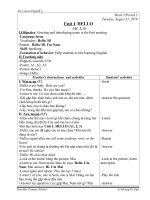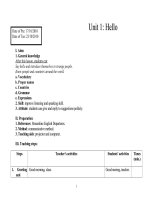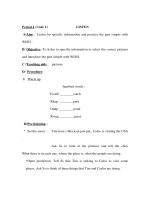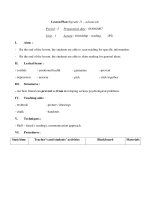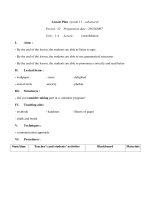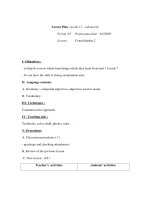Unit 1: Hello pps
Bạn đang xem bản rút gọn của tài liệu. Xem và tải ngay bản đầy đủ của tài liệu tại đây (135.14 KB, 5 trang )
Unit 1: Hello
Unit 1: Hello
I. Aims
I. Aims
1. General knowledge
1. General knowledge
After this lesson, students can:
Say hello and introduce themselves to strange people.
Know people and countries around the world.
a. Vocabulary
b. Proper names
c.
c. Countries
d. Grammar
d. Grammar
e. Expressions
e. Expressions
2. Skill
2. Skill
: improve listening and speaking skill.
: improve listening and speaking skill.
3. Attitude
3. Attitude
: students can give and reply to suggestions politely.
: students can give and reply to suggestions politely.
II. Preparation
II. Preparation
:
:
1. References
1. References
: Streamline English Departures.
: Streamline English Departures.
2. Method
2. Method
: communicative method.
: communicative method.
3. Teaching aids
3. Teaching aids
: projector and computer.
: projector and computer.
III. Teaching steps:
III. Teaching steps:
Steps
Steps
Teacher’s activities
Teacher’s activities
Students’ activities
Students’ activities
Times
Times
(min.)
(min.)
1. Greeting
1. Greeting
and
and
Good morning, class.
Good morning, class.
Good moring, teacher.
Good moring, teacher.
Date of Pre: 17/10/2010
Date of Tea: 23/10/2010
1
checking
checking
attendan
attendan
ce.
ce.
2. Warm up
2. Warm up
Give context when we meet strange people in work or class…what
Give context when we meet strange people in work or class…what
should we do in these cases to make friends?
should we do in these cases to make friends?
Students say in their
Students say in their
mother tongue:
mother tongue:
- Bạn từ đâu đến?
- Bạn tên gì?
- Bạn làm nghề gì?
- Tôi từ Thủ Dầu Một.
- Tên tôi là Nam.
- Tôi là sinh viên.
- …
5’
5’
3. New
3. New
lesson
lesson
Show some photos
Show some photos
Look at photos
Look at photos
35’
35’
The persons in these photos meet to each other in the first time. And
The persons in these photos meet to each other in the first time. And
they are making friend.
they are making friend.
Ask students: Do you know how to do that in English?
Ask students: Do you know how to do that in English?
Look at the photos.
Look at the photos.
We do not know
Ask students: Do you know how to do that in Vietnamese?
Ask students: Do you know how to do that in Vietnamese?
Students know they
Students know they
just practice this
just practice this
context.
context.
There are many ways to do that. This lesson give you one of those
There are many ways to do that. This lesson give you one of those
ways.
ways.
Ask students listen to the tape once.
Ask students listen to the tape once.
Listen carefully.
Listen carefully.
Teacher introduces vocobulary by writing vocabulry on the
Teacher introduces vocobulary by writing vocabulry on the
blackboard.
blackboard.
a. Vocabulary
a. Vocabulary
:
:
Teacher (n): giáo viên
Teacher (n): giáo viên
Student (n): sinh viên
Student (n): sinh viên
From(prep): từ
From(prep): từ
Write down
Write down
vocabulary.
vocabulary.
2
Where (adv): ở đâu
Where (adv): ở đâu
Very (adv): rất
Very (adv): rất
And (conj): và
And (conj): và
How (adv): thế nào, ra sao
How (adv): thế nào, ra sao
Fine (adj): khỏe, tốt
Fine (adj): khỏe, tốt
to be (v)
to be (v)
:
:
thì, là, ở
thì, là, ở
b. Proper names
b. Proper names
:
:
David Clark
David Clark
John
John
Peter
Peter
Linda Martin
Linda Martin
c. Countries
c. Countries
:
:
England: nước Anh
England: nước Anh
Canada: nước Canada
Canada: nước Canada
Teacher pronounces new word. Ask students repeat.
Teacher pronounces new word. Ask students repeat.
Students repeat after
Students repeat after
the teacher.
the teacher.
Teacher calls and asks students pronounce vocabulay and remind
Teacher calls and asks students pronounce vocabulay and remind
expressions.
expressions.
Pronouce vocabulary.
Pronouce vocabulary.
Teacher explains grammar.
Teacher explains grammar.
d. Grammar:
d. Grammar:
PERSONAL PRONOUN
PERSONAL PRONOUN
(Đại từ nhân xưng): dùng để thay thế cho
(Đại từ nhân xưng): dùng để thay thế cho
noun.
noun.
+ I (ngôi thứ 1 số ít): tôi, tớ…
+ I (ngôi thứ 1 số ít): tôi, tớ…
Ex: My name is
Ex: My name is
Thu
Thu
.
.
I
I
am a student.
am a student.
Thu
Thu
là một tên riêng (noun) đýợc thay thế bằng
là một tên riêng (noun) đýợc thay thế bằng
I
I
là một pronoun.
là một pronoun.
+ YOU (ngôi thứ 2 số ít): anh, chị, ông, bà, mày…
+ YOU (ngôi thứ 2 số ít): anh, chị, ông, bà, mày…
Students watch and
Students watch and
write down.
write down.
3
Ex:
Ex:
Nam
Nam
is watching TV. Có ai đó hỏi: What are
is watching TV. Có ai đó hỏi: What are
you
you
doing, Nam?
doing, Nam?
Nam là một tên riêng (noun) đýợc thay thế bằng
Nam là một tên riêng (noun) đýợc thay thế bằng
you
you
là một pronoun.
là một pronoun.
+ HE, SHE (ngôi thứ 3 số ít): anh ấy, chị ấy…
+ HE, SHE (ngôi thứ 3 số ít): anh ấy, chị ấy…
Ex: Hai is a worker. He is in work.
Ex: Hai is a worker. He is in work.
Hai
Hai
là tên riêng được thay thế bằng
là tên riêng được thay thế bằng
He
He
là một pronoun.
là một pronoun.
+ IT (ngôi thứ 3 số ít): nó, việc đó…
+ IT (ngôi thứ 3 số ít): nó, việc đó…
Ex: Nam works hard. It is very good.
Ex: Nam works hard. It is very good.
It là pronoun được dùng để thay thế cho hành động làm việc
It là pronoun được dùng để thay thế cho hành động làm việc
chăm chỉ.
chăm chỉ.
→
→
Qua các thí dụ trên chúng ta thấy rằng dùng pronoun để
Qua các thí dụ trên chúng ta thấy rằng dùng pronoun để
thay thế cho noun nhằm tránh lặp lại noun quá nhiều lần
thay thế cho noun nhằm tránh lặp lại noun quá nhiều lần
trong một đoạn dễ gây nhàm chán; thuận tiện trong việc
trong một đoạn dễ gây nhàm chán; thuận tiện trong việc
nói và viết.
nói và viết.
+ The present simple tense of To Be: có các dạng: am, is, are.
Kết hợp pronoun và chia động từ to be ở thì hiện tại đơn
Kết hợp pronoun và chia động từ to be ở thì hiện tại đơn
(the simple present tense)
(the simple present tense)
* Personal pronoun:
* Personal pronoun:
I
I
You
You
He
He
She
She
It
It
* The prensent simple tense of To Be:
* The prensent simple tense of To Be:
Am
Am
Is
Is
Are
Are
→
→
I am
I am
4
→
→
You are
You are
→
→
He
He
is
is
→
→
She is
She is
→
→
It is
It is
Teacher explains new expression.
Teacher explains new expression.
e. Expression
e. Expression
To be from: từ… đến, quê ở
To be from: từ… đến, quê ở
Ex: I
Ex: I
am from
am from
Thuan An-Binh Duong.
Thuan An-Binh Duong.
And you? = And how are you?: còn anh có khỏe không?
And you? = And how are you?: còn anh có khỏe không?
Teacher asks students learn by heart the vocabulary, grammar and
Teacher asks students learn by heart the vocabulary, grammar and
expression.
expression.
Turn on cassette player. Asks students listen to the tape again
Turn on cassette player. Asks students listen to the tape again
sentence by sentence and repeat.
sentence by sentence and repeat.
Listen and repeat.
Listen and repeat.
Teacher calls two students practice pronounciation as dialogue.
Teacher calls two students practice pronounciation as dialogue.
Students practice.
Students practice.
Divide class to smaller groups. Each group 3 or 4 students.
Divide class to smaller groups. Each group 3 or 4 students.
Do exercise 1 and
Do exercise 1 and
exercise 2.
exercise 2.
Go around the class to guide and repair students’ mistakes.
Go around the class to guide and repair students’ mistakes.
Work in group.
Work in group.
Listen to the tape once.
Listen to the tape once.
Listen carefully.
Listen carefully.
Ask studends look at the book and practice conversation as dialogue
Ask studends look at the book and practice conversation as dialogue
in the students’ book.
in the students’ book.
Repeat sentence by
Repeat sentence by
sentence.
sentence.
4.
4.
Homewo
Homewo
rk
rk
1. Learn by heart the expressions, vocabulary and grammar focus.
1. Learn by heart the expressions, vocabulary and grammar focus.
2. Listen to the tape again and repeat.
2. Listen to the tape again and repeat.
3. Do exercises 3 and 4.
3. Do exercises 3 and 4.
5’
5’
5
